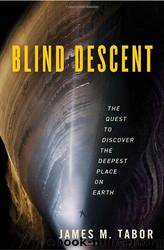Blind Descent: The Quest to Discover the Deepest Place on Earth by James M. Tabor

Author:James M. Tabor
Language: eng
Format: mobi, epub
Tags: Caving - History - 21st century, Geology, Science, Travel, Earth Sciences, Adventurers & Explorers, Special Interest, Sports & Recreation, General, Mountaineering, Caving, 21st century, Biography & Autobiography, Expeditions & Discoveries, History, Adventure
ISBN: 9781400067671
Publisher: Random House, Inc.
Published: 2010-06-15T02:51:11.991000+00:00
TWENTY-SIX
STONE-LED EXPEDITIONS IN 1995 and 1997 failed to find any other way through Huautla. Stone devoted 1998 largely to a massive project mapping Florida’s vast Wakulla Springs underwater cave system. The project provided him with a matchless opportunity to test and refine his rebreathers. It also afforded the media yet another chance to have at him. This time it came in the form of a writer from National Geographic Adventure, the offspring of National Geographic magazine, published by the National Geographic Society, which was one of Stone’s most important sponsors. Though he might have wished to, given his previous experience, there was no way Stone could keep NGA’s writer, Geoffrey Norman, away from the springs.
The Wakulla Springs Mapping Project was three months long; involved a team of 152, supported by 28 sponsors; and cost more than $1 million. It was also ambitious, even by the standards of Stone endeavors, with not one but four goals. Improving and testing the rebreathers was one. Demonstrating the worth of another Stone invention, a computerized, sonar-enabled device that produced three-dimensional, color underwater maps, was another. The third was demonstrating the utility of a “variable depth decompression habitat,” as Stone called it, a bell-shaped, submerged chamber that allowed divers to do long decompression stops in its warm, dry environment, rather than spending hours hanging off hand lines underwater. And there was the overarching reason for being there: mapping Wakulla’s caves.
Early on, one of Stone’s divers suffered a bout of decompression sickness (the bends) but survived. Later, another went into convulsions at 100 feet (oxygen toxicity, again) and nearly drowned. That diver was very lucky indeed to live. On February 15, a Nobel Prize–winning physicist and experienced diver named Henry Kendall, who had been working in support, did drown. All three had been using Stone’s rebreathers; the first two accidents occurred because the divers had failed to adjust their units correctly. An autopsy ultimately revealed that a stomach hemorrhage killed Kendall. “He would have died in Wal-Mart,” a Florida coroner was quoted as saying in Norman’s article.
These mishaps would have been bad enough by themselves, but Stone and his team also ran afoul of territorial local divers who had been mapping the springs on their own for ten years. The 160-diver group called itself the Woodville Karst Plain Project (WKPP). Given their professed commitment to science, WKPP’s divers might have welcomed the newcomers and, with their intimate knowledge of the springs, pitched in to help. Perhaps that was expecting too much of human nature, especially that of the WKPP leader, George Irvine. A muscular, combative, fitness-obsessed man, Irvine was another classic alpha who bitterly resented the Stone crew’s ballyhooed invasion of “his” turf.
“There are a lot of people who don’t like me, and I don’t really care,” Irvine told Norman, and one he especially didn’t care about was Bill Stone. One of his posts on a widely read divers’ Internet forum stated, “The bottom line is that in my opinion this guy [Stone] has no regard
Download
Blind Descent: The Quest to Discover the Deepest Place on Earth by James M. Tabor.epub
This site does not store any files on its server. We only index and link to content provided by other sites. Please contact the content providers to delete copyright contents if any and email us, we'll remove relevant links or contents immediately.
Endurance: Shackleton's Incredible Voyage by Alfred Lansing(4684)
The Motorcycle Diaries by Ernesto Che Guevara(4018)
Alive: The Story of the Andes Survivors by Piers Paul Read(3970)
Tokyo Vice: An American Reporter on the Police Beat in Japan by Jake Adelstein(3938)
Exit West by Mohsin Hamid(3779)
Apollo 8 by Jeffrey Kluger(3639)
Aleister Crowley: The Biography by Tobias Churton(3589)
Annapurna by Maurice Herzog(3425)
Full Circle by Michael Palin(3392)
Into Thin Air by Jon Krakauer(3315)
Kitchen confidential by Anthony Bourdain(3016)
In Patagonia by Bruce Chatwin(2877)
A Wilder Time by William E. Glassley(2818)
Finding Gobi by Dion Leonard(2784)
The Ogre by Doug Scott(2635)
Into the Wild by Jon Krakauer(2585)
L'Appart by David Lebovitz(2488)
The Stranger in the Woods by Michael Finkel(2458)
An Odyssey by Daniel Mendelsohn(2264)
